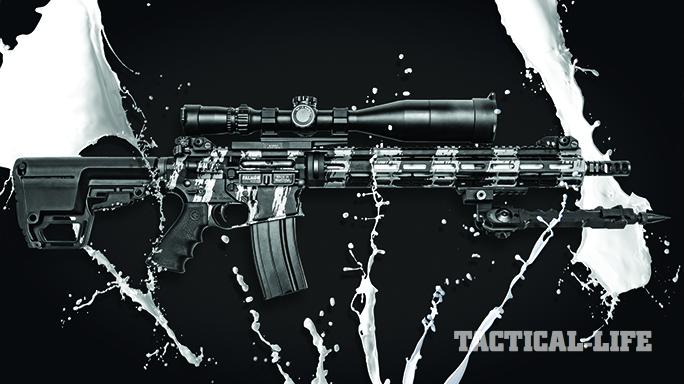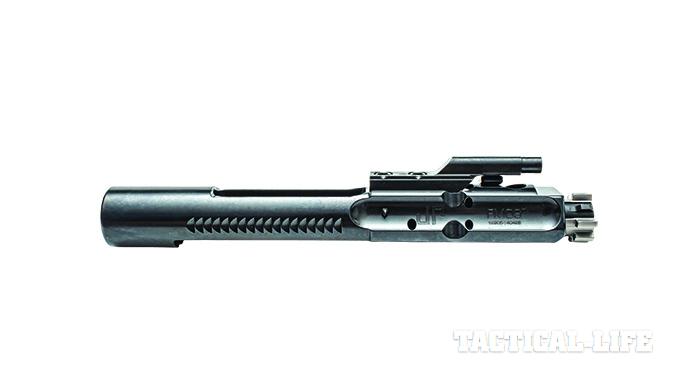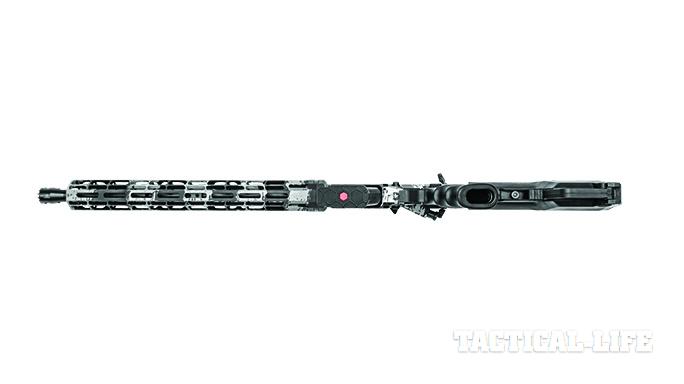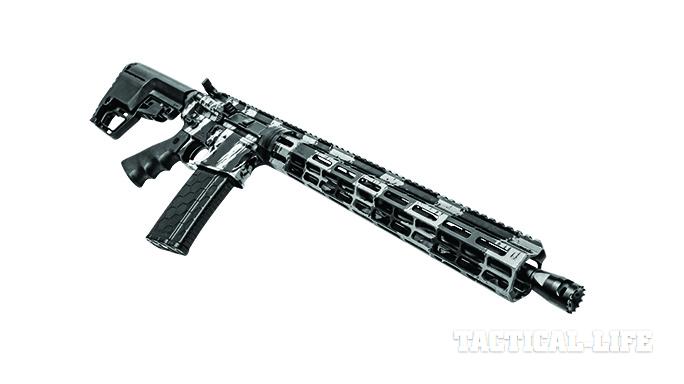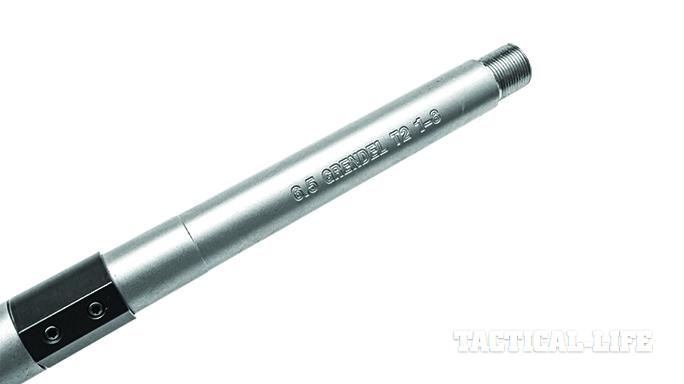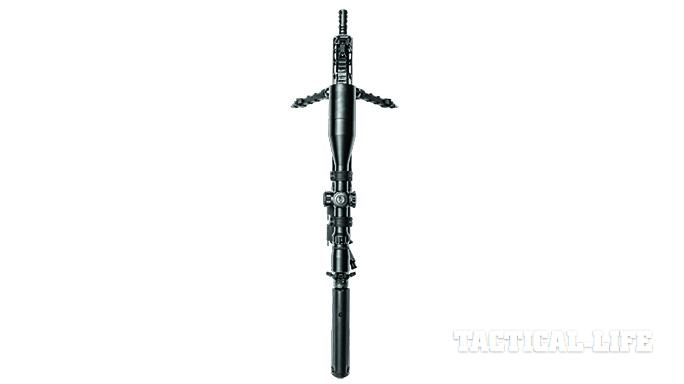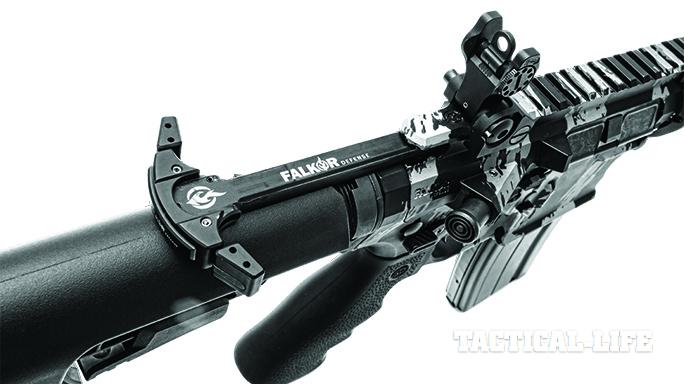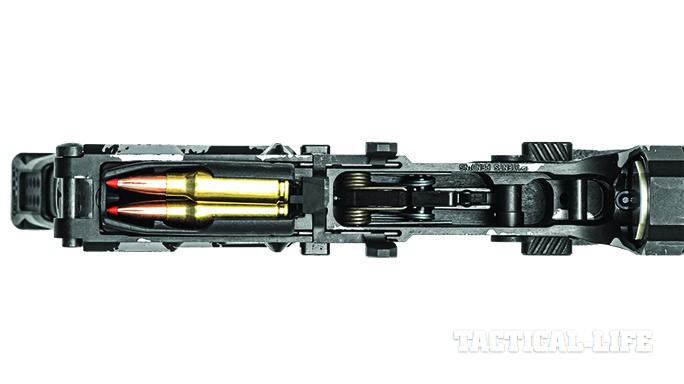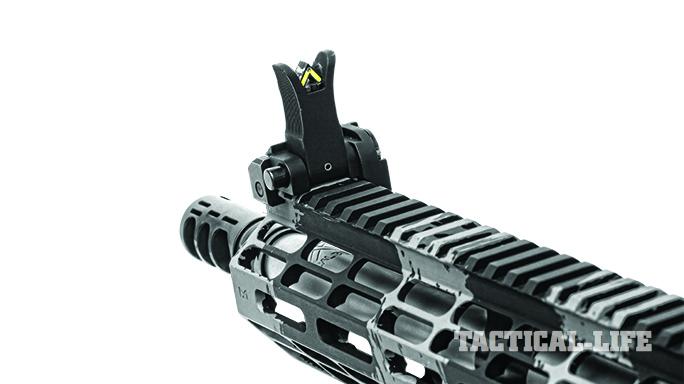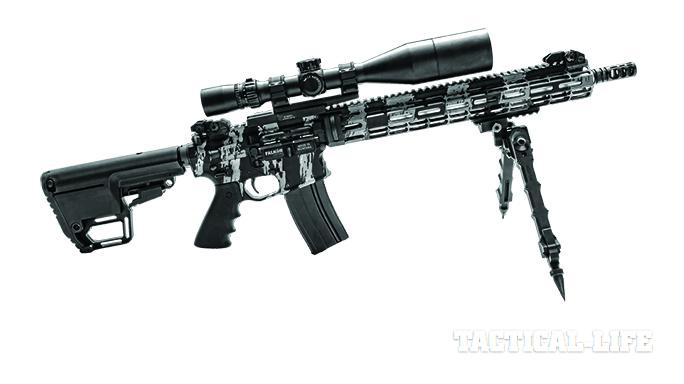A few months back, as we sat in a coffee shop discussing different AR-15 chamberings and their effective ranges, we wondered if there was one caliber that trumps them all for effectiveness out to 1,000 yards. Could we actually build an AR-15 that is capable of ranges usually reserved only for larger-caliber ARs or bolt-action rifles?
Back at the office, we scoured the Internet, researching forums and filtering the plethora of information (and sometimes misinformation) out there. One round kept coming up with the best potential for 1,000-yard effectiveness— the 6.5 Grendel. We asked Paul Scott, an expert on the round and one of the 65grendel.com moderators, a few questions on the topic. Could we make it out to 1,000 yards with an AR-15 built for the 6.5 Grendel? Which barrel length offers the most repeatable results for the average user? In short, the answer to the first question was yes, and any barrel from 16 to 24 inches would be able to get the 6.5 Grendel out to 1,000 yards. Of course, longer barrels would give the round added velocity to push beyond 1,000 yards, but a 16-inch barrel would be perfect for our needs.
Designed in 2003 by Bill Alexander and Janne Pohjoispää, the 6.5 Grendel was created to be an effective 200- to 800- yard, standard-AR-15-magazine-length cartridge with the potential and energy to remain lethal for thin-skinned game at over 1,000 yards. The constraints of the 5.56mm-sized magazine indeed proved to be a challenge for long-range capabilities.
Advertisement — Continue Reading Below
In a nutshell, they opted to use a shorter and wider-diameter case, and a long, streamlined bullet with a very high ballistic coefficient, in the end yielding a cartridge with a velocity of 2,350 fps at the muzzle and 1,508 foot-pounds of energy (fpe). Those figures were measured from Hornady’s 6.5 Grendel 123-grain A-MAX ammunition shot through a 16-inch barrel. In contrast, Hornady’s 55-grain 5.56mm GMX Superformance has a velocity of 3,130 fps but only 1,195 ffpe out of a 20-inch barrel. Indeed, these are impressive results for a round that was literally shoehorned into the AR-15. With this information in hand, we set out to see if we could make this a reality.

We started the 6.5 Grendel conversion with arguably one of the most advanced and accurate 5.56mm rifles in the industry today: The ambidextrous Falkor Defense Caitlyn PSR, which comes with a Proof Research carbon-fiber-wrapped barrel. The M-LOK handguard has a proprietary transition ring and barrel nut to enhance the fit between the barrel and upper for superb accuracy.
The billet 7075-T6 aluminum receiver set on the gun itself has some of the tightest tolerances we have ever seen, with absolutely no play in the mating surfaces. It’s as if the upper and lower are one solid aluminum block; it shows the Falkor team definitely takes pride in its aeros background and quality control. The magazine release and bolt catch are both mirrored, so shooting from either side isn’t a problem; the PSR’s controls are intuitively placed in the same location on either side.
Advertisement — Continue Reading Below

The mating between the barrel and receiver was the strongest selling point for us when deciding upon which rifle to base our build. A loose fit does not lend itself to accuracy, especially at long ranges where there are so many variables to consider when taking aim at a target. While it pained us to dismantle such a beautifully comprised rifle, it definitely gave some insight on how well the transitional rail was designed. By no means is this a quick-detachment system. The barrel and handguard assembly is held in place with eight machine screws and an equal number of setscrews and small dowels (which we learned are actually heat sinks) in the transition ring itself. This holds the barrel firmly in place with even pressure and without the need to over-torque the barrel nut, which would unevenly stress the aluminum and lessen accuracy.
We chose a 16-inch, 416R stainless steel, 1-in-8-inch-twist barrel from X-Caliber and paired it with a mid-length gas system. It was easy to install the barrel, and the upper and barrel fit tightly. To aid in the installation process, we warmed the upper with a heat gun to help slide the barrel extension into position, and they paired perfectly once cooled, as they should, with zero movement, even before we installed the barrel nut.
Up front, we installed a VG6 Precision GAMMA 762 muzzle brake to help tame the recoil, though we didn’t expect very much to begin with. The GAMMA 762 is helpful in taming lively rounds.
Advertisement — Continue Reading Below

After the barrel, converting a 5.56mm AR to the 6.5 Grendel requires replacing the AR-15’s bolt carrier group to accommodate the larger round. While we could have simply replaced the bolt itself, we didn’t want to deal with any possible fitting or tolerance issues. JP Enterprises is an industry leader known for creating top-tier rifles and add-ons, and the company’s bolt carrier groups are no different, so we went with JP’s Full Mass Bolt Carrier Group with a 6.5 Grendel JP Enhanced Bolt.
JP Enterprises did a phenomenal job putting the bolt carrier group together. Its roller-burnish bore allows the bolt to move inside the carrier without friction, while the polished exterior pieces and ejector have rounded edges to prevent shaving any brass, which could build up in the ejector hole and lead to potential failure.
The Falkor rifle came with a Geissele SSA-E two-stage trigger. Normally the trigger is the first thing we’d replace, but this unit is already perfect: Falkor Defense did a great job researching the best triggers on the market for the rifle in its 5.56mm form. What few people realize is that the Geissele’s hammer mass—on top of having a clean break and a short reset—yields the lowest preignition vibration compared to any other trigger on the market. To put it in layman’s terms: The mass of the hammer on standard mil-spec triggers has a tendency to push down ever so slightly on the receiver set during the hammer’s swing, resulting in a slight accuracy loss right before it strikes the primer. While subtle and mostly unnoticed, it is one more thing to think about when squeezing every MOA you can out of your rifle.
Advertisement — Continue Reading Below

After finishing the rifle itself, it was time to add a suitable optic. Of course, reaching out to a 24-inch target 10 football fields away is no ordinary feat. All the work, time and energy we poured in would go to waste if we couldn’t actually see our target clearly. The March Optics Tactical 3-24x52mm scope is an ideal choice for this application because it is compact and lighter than most optics in this class. Two illuminated first-focal- plane (FFP) reticles are available—MOA or mils—and we chose to go with the mil model for easier calculations. Aside from the FFP reticle, the scope has oversized elevation and windage knobs that are incredibly solid and well built with very positive clicks. There is also a zero-stop adjustment for elevation and options for illuminated or non-illuminated scopes. The scope’s Extra-low Dispersion (ED) glass is incredibly sharp and clear across the full magnification range.
Because everyone’s needs are different, most high-end optics do not come with scope rings, and the size of our March Optics scope required us to go with an extended mount that pushed the optic over the rail while keeping it rigidly in place on the upper. For this we turned to Bobro Engineering, which has been creating some truly innovative products since 2000.
During initial testing and short-range shooting, we found a standard base worked great to 700 meters, but to get our shots to 1,000 yards, the adjustments on the scope would not drop far enough. To make it out to 1,000 yards, we needed a 20-MOA base, which helps compensate and allows for much more drop. The mount we ultimately used features both a 20-MOA cant and the patented Bobro Lever/Auto-Compensation (BLAC) system.
Advertisement — Continue Reading Below

Although we didn’t expect the glass to fail and because iron sights would not be suitable for this kind of long-range work, we installed a set of Troy BattleSights on the rifle just in case, and replaced the Troy front sight post with a Blitzkrieg Chevron unit, which makes it easier to get on target if the gun is used in close quarters.
Finally, we come to the bipod—the final element needed to properly stabilize the firearm. We decided to add an Accu-Tac SR-5 to this build. While it looks robust and heavy, the bipod itself only weighs 19 ounces. Its legs are incredibly easy to extend and retract, and its height ranges from 6.25 to 9.75 inches. The bipod can also be adjusted for cant when the ground is not perfectly level.
Our first attempt at shooting the rifle was very disappointing. Our usual spot where we can range targets out to 2,500 yards was blocked by fallen trees due to recent storms in the mountains of western Washington State. We had to reschedule, and drove three hours to Yakima, Washington, to an incredible private range. It was equally snowy, but at least it was accessible. Luckily for us, the range already had metal targets set up set up at 340, 650 and over 1,000 yards—exactly what we were looking for, and definitely worth the trip! Zeroing the gun was incredibly easy; we had initially bore-sighted it just so we could get on paper without wasting ammo. Shot after shot, the rifle produced impressive 0.5-to 0.38-MOA results. We quickly knew we had a winner on our hands. With giddy excitement, we engaged the 340-yard target with a 2.4-mil elevation adjustment and a 0.25-mil wind hold. The first shot was right on target. After a few more shots to verify repeatability, we moved to the 640-yard target. Our ballistic computer gave us an elevation adjustment of 6.7 mils and a 0.5-mil wind hold. While our initial shots had some misses as the wind down range was a bit stronger and more unstable, we corrected to a 0.75-mil hold and finally got the hits we were looking for.
Advertisement — Continue Reading Below

Now the true test for the 6.5 Grendel—1,000 yards. At that distance, the Hornady Match 123-grain A-MAX bullet is still traveling at supersonic speeds with nearly 343 foot- pounds of energy. That’s similar to that of a 124-grain 9mm round at the muzzle—definitely enough power for thin-skinned game.
With the wind picking up to small, unpredictable gusts, we dialed the ballistic computer’s numbers into the scope: 12.5 mils of elevation and about 1.25 to 1.5 mils of windage. The snow on the ground only further deadened the incredible silence of the eastern Washington countryside and just echoed the incredible explosion of the 6.5 Grendel round leaving the gun. You could actually hear the bullet’s sweet whir flying to the target, finally reaching the 24-inch steel plate with a resounding gong. There was nothing more elating than hearing the sound of the lead hitting the steel at that distance. We accomplished our mission.
This may not be the most cost-effective build, but the rifle, the 6.5 Grendel round and the scope all worked so incredibly well together. The recoil was unbelievably light and stable, and the VG6 did an amazing job keeping the scope on the target while firing.
Advertisement — Continue Reading Below
Most quality AR-15s can be converted to the 6.5 Grendel by swapping out the barrel, bolt carrier group and magazine. Switching to the 6.5 Grendel is definitely a great upgrade if you want a gun that plays well in the 300- to 800-yard range and can stretch its legs all the way out to 1,000 yards.
|
Falkor Defense Caitlyn PSR
Accessories As Featured (Not Included) Advertisement — Continue Reading Below
|
For more information about Falkor Defense Caitlyn PSR, visit falkordefense.com.
This article was originally published in ‘Ballistic’ Summer 2016. To subscribe, visit outdoorgroupstore.com.
